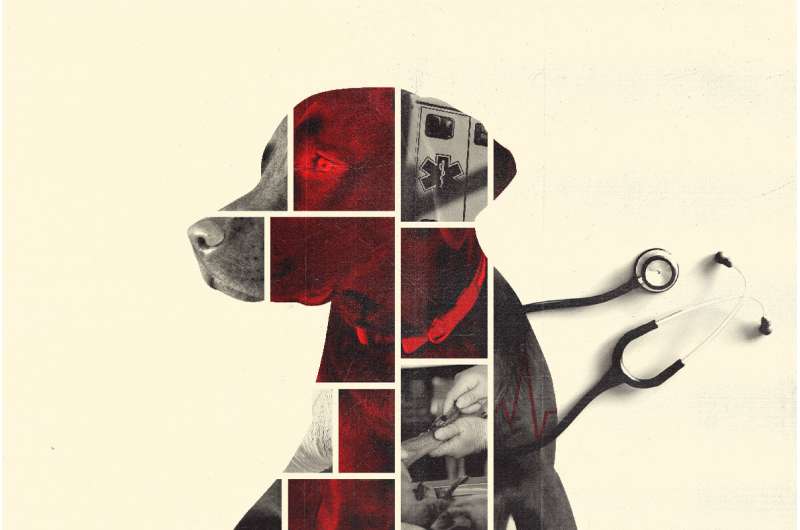Dog down: Effort helps emergency medical staff treat law enforcement K-9s

Recognizing a gap in care for law enforcement K-9s injured on the job, a team of veterinarians, emergency medical services experts and canine handlers has developed protocols for emergency medical service personnel who may be called upon to help treat and transport the injured dogs.
The protocols appear in a special report in the medical journal Prehospital and Disaster Medicine.
Law enforcement K-9s face the same dangers their human handlers confront, said Dr. Maureen A. McMichael, a professor of veterinary clinical medicine at the University of Illinois who led the effort to develop the protocols. Dogs on the job are sometimes shot or experience blunt force trauma, smoke inhalation, opioid drug exposure or other potentially life-threatening injuries.
While a few states are beginning to allow EMS personnel to treat and transport law enforcement K-9s to emergency veterinary facilities when those workers are not busy with human patients, little guidance or training is available to help them care for canine patients, said McMichael, who also is on the faculty of the Carle Illinois College of Medicine at the U. of I. The new protocols begin to address this shortfall, she said.
"Emergency medical personnel are well-trained in all aspects of prehospital care, but few are trained to apply their knowledge to canine patients," she said. "Our goal is to help them adapt their training to also serve the needs of law enforcement K-9 patients."
Such training is as important to the health and well-being of the EMS personnel as it is to the dogs, McMichael said. Even the best-trained dogs sometimes bite their handlers or others in moments of distress or confusion. With a maximum bite force of 800 pounds per square inch, the dogs can severely injure anyone nearby.
Some treatments may even enhance the danger. For example, naloxone—which may be administered to counter the dangerous effects of exposure to powerful opioids—can cause unconscious dogs to awaken in a frenzied, aggressive state. For this reason, the protocols recommend that a dog's handler immediately place a basket muzzle on an injured dog before anyone attempts to treat it. A basket muzzle is essential because dogs need to be able to pant with their mouths open to cool off, the authors report. If a handler is not available, the protocols offer guidance on how to safely muzzle a dog.
"Of course, it's strange for emergency medical personnel who normally treat humans to think about things like muzzles and other equipment designed for dogs, or to figure out how to administer drugs or diagnostic tests to dogs," McMichael said. "That's why we suggest they get preliminary training, establish relationships with emergency veterinary clinics, develop a list of facilities and their locations, and have on hand the phone numbers of emergency veterinary contacts they can call in the event of a serious K-9 injury."
The protocols offer guidance on a host of procedures that would not be immediately obvious to someone trained to stabilize, treat and transport human patients: They describe how to take a dog's vital signs, where to make an intramuscular injection, what kinds of analgesics work best in dogs, how to administer drugs intranasally, and how to adapt a human oxygen mask to a dog's snout when necessary. They also recommend that emergency medical staff have on hand a basket muzzle, leash, specially sized catheters, pediatric blood pressure cuffs, tennis balls and rawhide. Toys are good for reducing anxiety in dogs, the authors note.
There is no official record-keeping on the number of law enforcement K-9s that are injured or killed on the job, though some agencies voluntarily report the deaths. Over a period of about 30 months ending in July 2018, there were 68 reported law enforcement K-9s killed on the job in the U.S., McMichael said. Heat stroke took the lives of 21 dogs. Most of the others died from traumatic injuries, including blunt- and penetrating-force trauma, and drowning.
"These dogs risk their lives to protect the public and their human law enforcement handlers," McMichael said. "As more states sponsor legislation to improve their access to critical care, we also need to step up to make sure that the system is prepared to meet their medical needs in their moment of crisis."
More information: Ashley E. Mitek et al, The Carle-Illinois (Urbana, Illinois USA) Treatment Protocol for Law Enforcement K9s: Guidelines for Emergency Medical Services, Prehospital and Disaster Medicine (2019). DOI: 10.1017/S1049023X19004448
Provided by University of Illinois at Urbana-Champaign




















